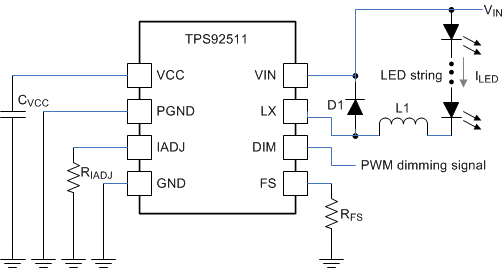SNVS901A March 2014 – May 2014 TPS92511
PRODUCTION DATA.
- 1 Features
- 2 Applications
- 3 Description
- 4 Revision History
- 5 Pin Configuration and Functions
- 6 Specifications
-
7 Detailed Description
- 7.1 Overview
- 7.2 Functional Block Diagram
- 7.3
Feature Description
- 7.3.1 Pulse Level Modulation (PLM) Control
- 7.3.2 Pulse Level Modulation (PLM) Operaion Principles
- 7.3.3 PLM Control enable Common-Anode Low-Side Sensing (CALS)Technique to Save Wiring
- 7.3.4 Internal Regulator
- 7.3.5 Setting The Switching Frequency
- 7.3.6 Setting The LED Current
- 7.3.7 Integrated MOSFET
- 7.3.8 Inductor Selection
- 7.3.9 Integrated MOSFET Current Limit
- 7.3.10 PWM Dimming Control
- 7.3.11 Analog Dimming
- 7.3.12 High Voltage Buck Configuration
- 7.3.13 Thermal Foldback
- 7.3.14 EMI Consideration
- 7.4 Device Functional Modes
- 8 Application and Implementation
- 9 Power Supply Recommendation
- 10Layout
- 11Device and Documentation Support
- 12Mechanical, Packaging, and Orderable Information
Package Options
Mechanical Data (Package|Pins)
- DDA|8
Thermal pad, mechanical data (Package|Pins)
- DDA|8
Orderable Information
1 Features
- Wide Input Voltage Range: 4.5 V to 65 V
- Requires NO External Current Sensing Resistor
- Requires NO External Loop Compensation
- Ease of Use, Needs Minimum 5 Components
- 1000:1 Contrast Ratio Feasible
- Single Layer PCB Feasible
- Can Work as High Voltage Buck Regulators
- Can Work as Linear Current Shunt Regulators
- Integrated Low-side N-channel MOSFET
- LED Current Programmable up to 0.5 A
- Typically ±3.6% LED Current Accuracy
- Switching Frequency Programmable From 50 kHz to 500 kHz
- Current Limit Protection
- VCC Under-voltage Lock-out
- Thermal Shutdown Protection
- Support Analog Dimming and Thermal Foldback
- Power Enhanced SOIC-8 Exposed Thermal Pad Package (HSOP-8)
2 Applications
- High Power LED Driver
- Architectural Lighting
- Office Troffer
- Automotive Lighting
- MR-16 LED Lamp
3 Description
The TPS92511 is an easy to use 65V constant current buck converter for driving a single LED string with current up to 0.5A and efficiency up to 95%. Only 5 external components are required for basic operation and single layer PCB layout is feasible because of the integration of a N-MOSFET, no external current sensing resistor, no external compensation and the proper terminal assignment. A high-value external resistor programs the LED current so that fine tuning of the LED current can be achieved. Another high-value external resistor programs a constant switching frequency from 50kHz to 500kHz. EMI design becomes easier as a result of constant switching frequency. The TPS92511 provides a wide input voltage range from 4.5V to 65V. By adding simple external circuits, the device can handle applications with even higher input voltages.
The TPS92511 employs a proprietary control scheme to regulate the LED current without the need of sensing the LED current directly. It applies a floating buck topology with a low-side N-channel power MOSFET, which does not need boot-strapping capacitor. For multiple channel systems, the floating buck topology together with the proprietary control scheme allows a common-anode connection of the LED strings without an external current sensing network. This significantly reduces the number of wiring and as well as overall manufacturing cost.
The TPS92511 has very fast PWM dimming response time. For example, if the switching frequency is 500 kHz, the minimum DIM pulse width is 6µs and the dimming frequency is 150Hz, a contrast ratio of more than 1000:1 can be achieved.
The TPS92511 is available in the Power Enhanced SOIC-8 exposed thermal pad package.
- For all available packages, see the orderable addendum at the end of the datasheet.
